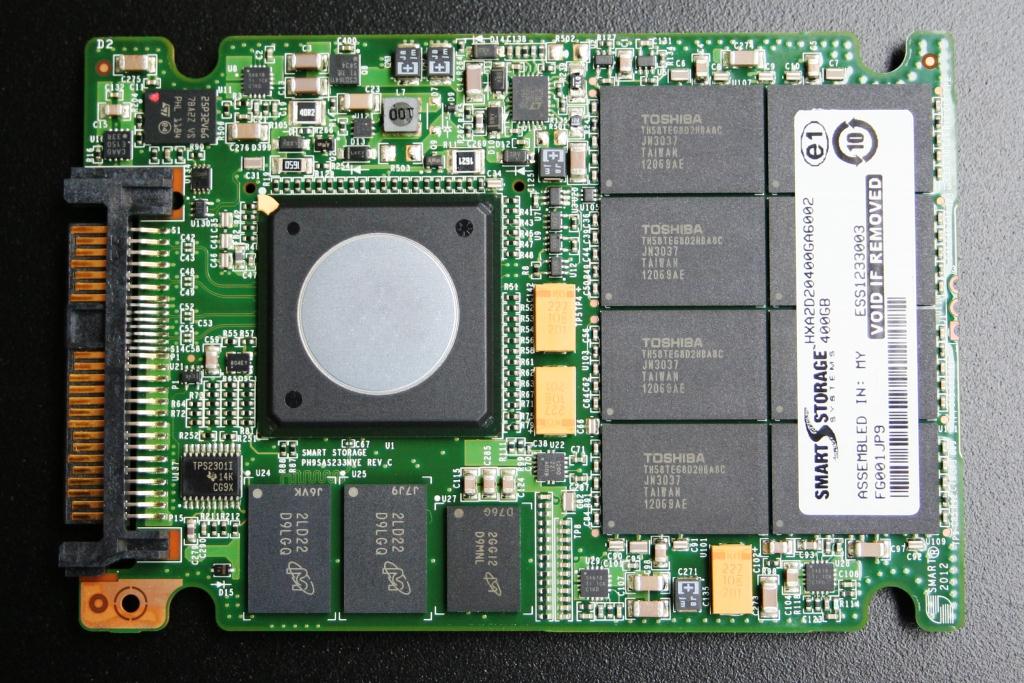Proprietary signal processing techniques are a big factor too, in essence helping the drive to understand what’s going on with the flash in more detail. Smarter wear leveling is important too; the Optimus can wear level on a global level, instead of just on a per-device level like more conventional drives. It’s all part of what SMART calls Guardian, the collective term for their enhanced data protection/endurance/speed techniques.
At the bottom are three Micron DDR3 IC’s, a total of 5gbits (640MB) for the drive’s volatile cache. The other 256GB of NAND are on the back, along with the controller.
SMART doesn’t use their own proprietary controller, instead relying on a third party to supply the silicon. They have asked us not to disclose specifically which make and model it is, but it’s hardly a state secret. Most companies simply aren’t in the position of being able to develop their own silicon for a drive controller (or wouldn’t want to anyway), but fortunately there are alternatives with the flexibility to add lots of custom technology through firmware. Firmware ultimately ends up being more important than the controller itself in many or most circumstances. Good FW can make a mediocre drive great, or a great drive a flaming dumpster fire.
TEST BENCH AND PROTOCOL
In testing the Optimus, we’ll be using one of our enterprise/workstation enterprise testing systems.
 We’ll be using Red Hat Enterprise Linux and/or CentOS for most all of our enterprise testing and the Optimus is no exception. Linux has less overhead and is generally more flexible when it comes to evaluating performance. That said, our enterprise test bench is OS agnostic.
We’ll be using Red Hat Enterprise Linux and/or CentOS for most all of our enterprise testing and the Optimus is no exception. Linux has less overhead and is generally more flexible when it comes to evaluating performance. That said, our enterprise test bench is OS agnostic.
We’ll apply a few new standardized testing techniques in addition to some of our older test protocols. We want to isolate and explore the individual performance of the review drives as accurately as we can. As the test bench evolves, we hope the result is a more tangible, relevant performance evaluation.
A special thanks to Asus, Crucial, OCZ, and Fractal Design for sponsoring our Enterprise Test Bench.
CAPACITY
Out of the 512GB of flash on board, 372GB are user addressable. 64GB goes to SMART’s F.R.A.M.E. parity scheme which keeps the drive from meeting it’s demise just because a single die gives up the ghost. 48GB is over provisioning, while 7% of the remaining capacity is considered spare area (the distinction is largely a matter of semantics). 28% of the total amount of flash goes to internal functions, 72% goes to available capacity.
 The SSD Review The Worlds Dedicated SSD Education and Review Resource |
The SSD Review The Worlds Dedicated SSD Education and Review Resource | 

Firmware ultimately ends up being more important than the controller itself in many or most circumstances. Good FW can make a mediocre drive great, or a great drive a flaming dumpster fire.
That was beautiful, thank you for the insight. 🙂
The SSD market is RED HOT right now! Thanks Les for all the good stuff!
Reliability and predictable performance is very important. I wish consumer-oriented drives would be more like that. As a side note, what’s going on with the 12Gbps connection? Did you manage to sort it out? Perhaps it will work fine with Win7, WIn8 or Server 2012?
this is beautiful.. Wish my old kinston had the speed and reliability of this.